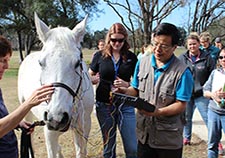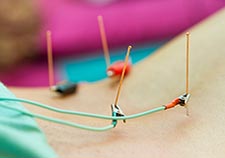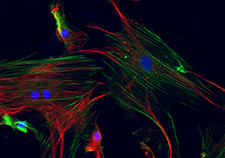Office of Research & Development |
 |

VA Research Currents archive
March 16, 2017
By Mitch Mirkin
VA Research Communications

Dr. Huisheng Xie, director of the Chi Institute of Traditional Chinese Veterinary Medicine in Florida, trains students in administering electroacupuncture to a horse. He collaborated with VA's Dr. Fletcher White and others on a study of the therapy's mechanisms. (Photo: ©Chi Institute/2016-2017)
A series of tests involving humans, horses, and rodents has provided the most thorough picture yet of how electroacupuncture—a modern version of the ancient Chinese healing art—eases pain and promotes tissue repair.
The findings, by researchers at several institutions in the U.S. and South Korea, appeared online March 16 in the journal Stem Cells.
"We have discovered a mechanism which explains the benefits of electroacupuncture for treatment of injury-induced pain, and for tissue regeneration," said Dr. Fletcher A. White, one of more than 40 authors who contributed to the work.
The key finding was that electroacupuncture triggers the release of mesenchymal stem cells (MSCs) into the bloodstream. These are adult stem cells found mainly in the bone marrow. The hardy cells, which multiply easily and turn into various tissue types in the body, are being widely studied for their healing potential.

Electroacupuncture uses the same points on the body as traditional acupuncture but relies on small electrical currents, in addition to the needles themselves, for stimulation. (Photo: ©iStock/seiki14)
The research was the culmination of efforts by four senior authors: Dr. Maria B. Grant, a professor of ophthalmology at Indiana University, began the work with Dr. Huisheng Xie, director of the Florida-based Chi Institute of Traditional Chinese Veterinary Medicine, in 2011 at the University of Florida. The work continued at Indiana University with the support of Dr. Mervin Yoder, director of the Herman B. Wells Center for Pediatric Research, and White, a neuroscientist at the Richard L. Roudebush VA Medical Center in Indianapolis, and a professor of anesthesia and pharmacology at Indiana University School of Medicine.
The study involved functional brain scans, blood tests, artery imaging, gene sequencing, and other lab methods. The researchers were able to trace electroacupuncture's actions on the brain and nervous system, resulting in the release of MSCs. The researchers believe the cells may be responsible for a range of therapeutic effects, such as the release of proteins that quell inflammation, and of the body's own natural opioids.
"We have discovered a mechanism which explains the benefits of electroacupuncture for treatment of injury-induced pain, and for tissue regeneration."
The main brain region affected was the hypothalamus, which controls the body's autonomic nervous system. This system works on an involuntary and reflexive basis, without our conscious thought, to regulate heart rate, blood pressure, digestion, and many other body functions.
In the study, functional MRI scans, which track blood flow in the brain, showed increased connectivity between the hypothalamus and the amygdala, the brain's emotion center.
The study showed how stimulating the peripheral nervous system with needles leads to "rapid activation of the hypothalamus," according to White. This happened within 9 to 22 minutes, depending on the species. And then, within two hours, MSCs surged within the bloodstream.

This fluorescence image shows mesenchymal stem cells derived from adult bone marrow. The cell nuclei are shown in blue. (Photo: Ames Laboratory, U.S. Dept. of Energy)
Previous studies have suggested various theories for how acupuncture works, at least for pain. These have focused on the release of neurotransmitters, neuropeptides, and immune signaling proteins, or cytokines, in the central nervous system, and endogenous opioids into inflamed tissue.
The new findings don't necessarily contradict any of these theories, but add new insight, relating to the role of MSCs in the pain-relief process.
The downstream effects of MSCs are being studied further in the lab, says White. He believes they can be harnessed as a therapeutic tool in their own right.
To that end, a study is set to begin this spring at the University of Florida on using electroacupuncture-mobilized cells for treating acute tendon injuries in horses. The study will harvest the MSCs mobilized into the blood and expand them "ex vivo," or in culture in the lab. The aim is to get the cells to multiply without changing their properties. The researchers will then inject them back into the injured horses. The team hopes their findings will lead to FDA approval of the treatment for horses. Meanwhile, Grant and Yoder are pursuing the same approach in human studies.
The benefits of acupuncture—including the electric form—are well accepted, even in mainstream medicine, for pain and some other conditions. Like traditional acupuncture, electroacupuncture involves inserting needles into the body to stimulate certain points, as described in traditional Chinese medicine. But with the electric version, the stimulation comes from a small current, not just from the needle. A similar technique, called transcutaneous electrical nerve stimulation, or TENS, supplies a current from electrodes taped to the skin.
Conventionally, TENS has been applied specifically to the injury site. More recently, clinicians are using it on traditional acupuncture points, as a needle-free form of electroacupuncture. Either way, White and his colleagues believe it, too, has the potential to trigger the release of MSCs, and that this may help explain its therapeutic action.
In some of the experiments, when the researchers stimulated a different set of points, the result was a release not of MSCs but of immune cells resembling macrophages. The name is Greek for "big eaters," and these immune cells gobble up pathogens.
"Based on traditional medicine, different immune points in humans will activate the immune system in different ways," explained White. "We are conducting additional experiments to better understand the release of specific cell types."
Importantly, the results from stimulation—whether the release of MSCs, or macrophage-life cells—were consistent across humans, horses, rats, and mice.
"While the effect of EA on analgesia [pain relief] is well-accepted, until now the effect of EA on the release of reparative cell populations was largely unknown," wrote the study team in their paper. "Of equal importance is that the effect of EA is uniform across 4 species."
The horses used in the study had been injured during training for national dressage competitions. Veterinarians often use electroacupuncture as a treatment option, says White.
The six people who took part in the study were healthy volunteers. Even though they weren't in pain, images of their brain still showed the effects of the electroacupuncture treatment—namely, the activation of the hypothalamus and increased blood flow between it and the amygdala.
According to the study authors, it's unclear whether the exact same effects would be seen with standard acupuncture. That would require more research.
The study was funded mainly by the National Institutes of Health.